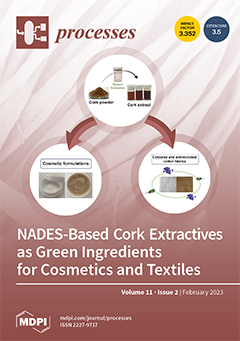Greenhouse gases, the main cause of global warming, are generated largely in the energy sector. As the need for technology that has reduced greenhouse gas emissions while producing energy is on an increase, CCU technology, which uses CO
2 to produce CH
4
[...] Read more.
Greenhouse gases, the main cause of global warming, are generated largely in the energy sector. As the need for technology that has reduced greenhouse gas emissions while producing energy is on an increase, CCU technology, which uses CO
2 to produce CH
4 (SNG energy, synthetic natural gas), is drawing attention. Thus, the reaction for converting CO
2 to CH
4 at a specific temperature using a catalyst is CO
2 methanation. The field of CO
2 methanation has been actively studied, and many studies have been conducted to enhance the activity of the catalysts. However, there is a lack of research on the variables that may appear when CO
2 methanation is attempted using emissions containing CO
2 generated from industrial fields and bio-plants. According to previous studies, it is reported that realistic feed gases from gasification or biomass plants contain a significant amount of CO. this study is a follow-up study focused on the application of CO
2 methanation in various real processes. In the CO
2 methanation reaction, a study was conducted on the catalyst efficiency and durability of CO gas that can coexist in the inlet gas rather than CO
2 and H
2 gas. The CO
2 methanation activity was observed at 200–350 °C when 0–15% CO coexisted using the Ni-Ce-Zr catalyst, and the operating variables were set for optimal SNG production. As a result of adjusting the ratio of inlet gas to increase the yield of CH
4 in the produced gas, the final CO
2 conversion of 83% and CO conversion of 97% (with 15% CO gas at 280 °C) were obtained. In addition, catalytic efficiency and catalyst surface analysis were performed by exposing CO gas during the CO
2 methanation reaction for 24 h. It showed high activity and excellent stability. The results of this study can be used as the basic data when applying an actual process.
Full article





